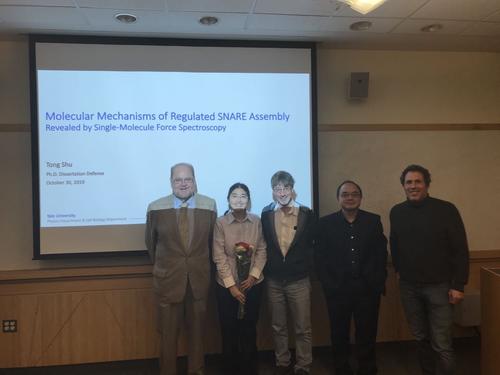
On October 30, 2019 graduate student Tong Shu successfully defended her thesis “Molecular Mechanisms of Regulated SNARE Assembly Revealed by Single-Molecule Force Spectroscopy” (advisors James Rothman & Yongli Zhang)
Tong Shu explained, “One of the most critical open questions in neuroscience is the molecular mechanism of fast neurotransmitter release. More specifically, how is the neurotransmitter release regulated at synapse to achieve sub-millisecond timescale upon Ca2+ influx. Neurotransmitters are initially stored within each synaptic vesicle and their release at synapse is mediated by membrane fusion between synaptic vesicle membrane and plasma membrane. If solely depending on thermal fluctuation, the fusion process would take days on average. This is contrary to the physiological sub-millisecond timescale, which is much faster than any other biological membrane fusion process. To facilitate this fast neurotransmitter release, external energy is required and this comes from the zippering energy of three SNARE proteins (syntaxin, VAMP2 and SNAP-25) by forming SNARE complex. The zippering process of SNARE complex is also coupled with membrane fusion. Surrounding SNARE proteins, several regulatory proteins including Munc18-1, Munc13-1, Synaptotagmin have been identified. All together, they form a delicate synaptic fusion machinery. However, how these proteins cooperate to mediate fast synaptic vesicle fusion is still not fully understood. The aim of my thesis research is to understand how these proteins collaborate to initiate SNARE protein assembly, one key aspect of this fusion process. Using high-resolution single-molecular spectroscopy (optical tweezers), we identified an intermediate molecular state along the SNARE assembly pathway. It involves Munc13-1 and Munc18-1 binding syntaxin and VAMP2, and forms a tetrameric complex that facilitates association of SNAP-25 with the two templated SNAREs into a ternary SNARE complex. This intermediate state ensures the fast and accurate SNARE complex assembly, thus contributing to the first step of fast neurotransmitter release process.”
Tong Shu is still deciding on her future plans.
Thesis abstract: Neurons in the brain communicate with each other by release of neurotransmitters at synaptic junctions. Neurotransmitter release is mediated by three membrane-anchored SNARE proteins (soluble N-ethylmaleimide sensitive factor attachment protein receptors) and various regulatory proteins, including Munc13-1, Munc18-1, Synaptotagmin, complexin, NSF (N-ethylmaleimide sensitive factor) and SNAP (soluble NSF attachment protein). By forming proper SNARE complex, SNARE proteins couple their folding and assembly to membrane fusion in a regulatory protein-dependent manner. To achieve sub-millisecond synaptic vesicle fusion, SNARE assembly pathway needs to be highly regulated in several aspects, promoting fast and accurate initial SNARE assembly, clamping half-zippered SNARE complex before Ca2+ influx and accomplishing full SNARE zippering for membrane fusion within sub-millisecond upon Ca2+ influx. However, the exact molecular mechanisms of these processes are poorly understood despite decades of researches. Here, we addressed one of the processes using high-resolution optical tweezer. We found that Munc13-1, Munc18-1, and two SNAREs – Syntaxin-1 and VAMP2 associate into a weak tetrameric complex. The third SNARE protein SNAP-25B rapidly binds the two SNAREs in the complex to form a proper ternary SNARE complex, which likely displaces the two regulatory proteins from the resultant four-helix bundle. Therefore, Munc13-1 and Munc18-1 cooperatively chaperone SNARE assembly, a process required for neurotransmitter release. In summary, the findings demonstrate new evidences in understanding the molecular mechanism of sub-millisecond fast Ca2+-triggered synaptic vesicle exocytosis.